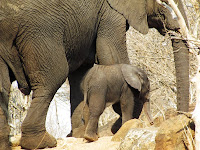It started quite innocently - the head of a Water leguan (Monitor/Lizard family) appeared at the water's edge . . .
. . . but the next moment it spun around & a lot of slashing & spinning about ensued.
On closer inspection this strangely dinosaur-look-alike appeared to have caught a fish.
As if to "prove a point", the leguan protectively hovered over its unexpected prey - feeling threatened by my pressence?
Well, its flipping tongue certainly made this reptile appear aggressive - trying to intimidate me?
When this didn't work, the leguan turned around, although it continued to "eye" me suspiciously.
Still not at ease, the leguan "took possession" again of its prey . . .
. . . and finally started to feed - which looked more like nibbling, though.
Since this "took place" at the Chobe River (in Botswana), other reptiles are also in abundance - like a (Nile) crocodile.
Last but not least & to "round off" this reptile story - 2 tiny geckos eyeing each other ideally "round off" another story.
Friday, October 28, 2011
A Reptile Story
Tuesday, October 25, 2011
An Elephant Story
Whilst cruising on the Chobe River during the last tour, a herd of elephant came into view. Once they moved apart . . .
. . . a tiny elephant came into view - & it was battling to cross a ditch.
Obviously noticing how the tiny youngster battled, other elephants moved closer - appearing really concerned & prepared to somehow assist.
The tiny elephant didn't appear to notice this & instead reached for sustenance = "comfort food". . . .
. . . whilst two elephants "demonstarted" how it could be done = how to cross an obstacle with a "little help from a friend".
The little one didn't appear impressed, though . . .
. . . and again reached high for comfort = sustenance - whilst its mother patiently waited for her youngster to "learn a trick or two".
Eventually her patience was rewarded & the little one did manage to cross the ridge of the ditch = "mission accomplished" . . . .
. . . but the youngster was obviously exhausted & again moved underneath the protective "shield" of its mother's large body = resting in the shade for a moment.
Eventually the elephants moved on - now that the tiny one had mastered the obstacle - but its mother still protectively assisted her youngster along.
Bravely now the little one demonstrated that it was able to follow in the footsteps of the larger "trailblazers" . . .
. . . whilst we had one last glimpse and sighed in relief that this story had a "perfect" ending.
Sunday, October 23, 2011
Sun has set


As one of the ladies in our group commended: if you would suddenly see this image (instead of proggressively watching the sun set), what would you think it represents? Perhaps a "lightened" dome of some kind?
Accordingly I was excited to detect this rare & tiny antelope under a bush in the Etosha Game Reserve (Namibia) = a (Damara) dik-dik. It was difficult to "clearly" photograph in the underbrush . . .
. . . but the next day we had the opportunity to see this little antelope at "close quarters" at the (private) Mt Etjo Safari Lodge.
For me - a special moment when moments later, I could photograph this magnificent Roan antelope.
Towards the end of the tour & in the Chobe Game Reserve, we also saw this related Sable antelope - if far in the distance.
Back at Mt Etjo, where a great variety of often "unusual" wild animals roam the reserve, this Black wildebeest reminded me of a bull ready to fight (= in a bull-ring).
I did say: unusual - because seeing a white blesbok in the wild certainly is an unusual sight!
Well, at Mt Etjo finding a white blesbok isn't unusual at all, because there were quite a few of them around - like this white youngster. Also, we were told, these are white - & NOT albino!! - animals (because they don't have pink eyes!
Tuesday, October 4, 2011
October Flower
Sunday, October 2, 2011
Camera - Action!




And as if "on command" we saw an adult Bateleur soon after :)



Even the Chinese lantern bushes looked "fuller" than I've ever seen them before!?
































